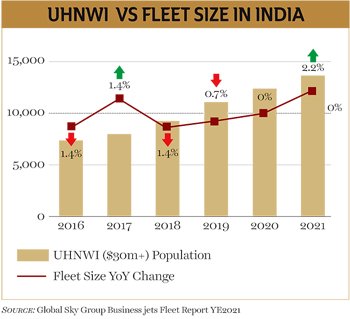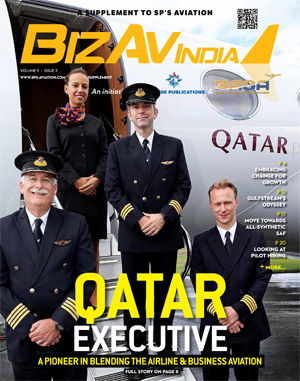The Dawn of Fractional Aircraft Ownership in India?
Flying high or grounded dreams, unraveling the intricate path and potential of Fractional Aircraft Ownership in India
 | By JAYANT NADKARNI |


In the last few years, there has much speculation about the start of fractional aircraft ownership in India. But is it really going to happen? What does the future behold? Will we start seeing large business houses jumping in? Will we see large foreign fractional majors like NetJets, enter India? How will things unfurl?
These are all risky questions to answer. Any over simplistic attempt to ‘crystal gaze’ can become obsolete and the subject of ridicule quickly. There are many nuances which should be understood before any such attempt is made.
To be absolutely clear, this article pertains to fractional ownership with actual title sharing as it happens in the western world. This is the more proven and popular model globally. This is the model that can gain huge traction in India. We are not talking about simply creating ‘co-usage interests’ via proportionate shareholding of a company. Such examples are already functioning in India, but they are not scalable and do not offer the benefits that the traditional fractional model does.
PERSPECTIVE
India is at least 30 years behind the USA in the fractional businesses. The US has perfected the model over time. And what a market response it has got! Fractionals today are by far the most successful ‘business model’ globally for small aircraft in aviation. In fact, industry leader, NetJets, is more like a mini airline with over 750 fractionally owned business jets. Other fractionals behind NetJets’ wake are also no small fries, with most of them having large and growing fleets.
THE QUESTION THEN BEGETS
Why has this model not picked up in India, in 70+ years of freedom? Isn’t it no brainer for a ‘capital constrained’ country like India? There is also a ‘sort of democratisation’ in the use of small private aircraft, beyond just the ‘top most’ corporates in India. This is because the small aircraft now become affordable to the much larger ‘middle of pyramid’ corporates. That is indeed a huge market.
A few decades back some pioneering companies did try to offer fractional ownership services in India, but they met with no success. One such attempt was by a company called BJets, which in fact, was started with former NetJets professionals at the helm! They did start operations with much fanfare, deploying five aircraft (Hawker 850XPs and Citation Jets), but folded up quickly. In hindsight, back then:
- Neither the market was ready in India
- Nor the aviation regulatory and evolving taxation structures were conducive.
SO ARE WE READY NOW IN 2024? SHOULD WE BE OPTIMISTIC?
Let’s take the Market First. Powered by sustained economic growth over the past few years, India today has roughly 15,000+ UHNIs (Ultra High Net Worth Individuals with minimum net worth of $30 million each), a number that is projected to touch 19,000 in five years. And 19 per cent of this segment is under 40 years in age, or Next-Gen. You can gauge any market size by attributing a conversion percentage, which can of course, vary depending on your different perceptions. But also keep in mind that coupled with this market profile, is the fact that the Indian luxury market is expanding fast and projected to grow to a staggering $200 billion by 2030 as per a report by Bain and Co. How much can people keep buying the same old luxury products-like expensive cars, high end holiday homes etc? The time may be ripe for a new product class to come in! This is where a fractional aircraft ownership product can be a hit for Industry Captains, or to anyone who attaches a premium to getting a significant boost in their strategic mobility.
THE US HAS PERFECTED THE MODEL OVER TIME, AND FRACTIONALS TODAY ARE BY FAR THE MOST SUCCESSFUL ‘BUSINESS MODEL’ GLOBALLY FOR SMALL AIRCRAFT IN AVIATION
The market just needs to be able to justify purchasing such a product (aircraft, fractionally owned) in the knowledge that it allows them:
- Drastically lower capital outlays,
- Defined operational cost outlays,
- Peace of mind in aircraft availability, safety, and liquidity
There are aircraft categories for different budgets, which then becomes even more affordable in the fractional ownership model. In contract, pure Charter and pure Timeshare can never replicate the success that fractional ownership has achieved, since the cost of the asset is spread across many rich individuals or companies. Not so in charter hire or timeshare (which is really bulk charter) models. In any case, the installed aircraft base is so small in India. Where are the aircraft if you need one immediately? If it all, you will not get the most ideally suited one for your mission. The market is already sensing these facts. There is nothing like owning your own Car vs. always hiring a Cab. It’s the same with aircraft, even if fractionally owned.
Yes, one can broadly say the market is ready. What is needed is a credible service offering in the market. So, are there any companies who have made the move? Not really, but it also won’t take too long for existing charter companies to launch their own fractional ownership services. The difference on who will succeed will lie in the execution. Those who plan their fractional foray out well, who put in place the right contracts thoughtfully drafted, who brief potential customers thoroughly with no communication gaps, who don’t oversell and underdeliver, who deploy a solid sales team with a strong customer focus.....such companies have a good chance at success. Others who treat the business as a casual sidekick to charters will probably just end up hurting themselves and the market. Potential customers would do well to select a fractional company very carefully.
COUNTRY OVERVIEW: FLEET SIZE VS BILLIONAIRES VS POPULATION
| Country | Fleet Size Vs. Billionaires | Fleet Size | Billionaires | UHNWIS ($30M+) | Population (Millions) |
| New Zealand | 14.5 | 29 | 2 | 3,118 | 5 |
| Australia | 4.75 | 209 | 44 | 20,874 | 26 |
| Malaysia | 2.38 | 50 | 21 | 712 | 33 |
| Indonesia | 2.29 | 48 | 21 | 1,403 | 276 |
| Philippines | 2.27 | 50 | 22 | 313 | 111 |
| Vietnam | 1.6 | 8 | 5 | 1,234 | 98 |
| Singapore | 1.48 | 62 | 42 | 4,206 | 5 |
| Japan | 1.33 | 65 | 49 | 31,516 | 125 |
| Thailand | 1.16 | 36 | 31 | 1,272 | 66 |
| India | 1 | 140 | 140 | 13,637 | 1,393 |
| China | 0.64 | 480 | 745 | 1,07,761 | 1,444 |
| South Korea | 0.47 | 20 | 43 | 6,635 | 52 |
LET’S COME TO THE REGULATIONS NEXT
In October 2022 there were news reports that India’s Ministry of Civil Aviation was about to permit the fractional model. The euphoria that followed was short lived, and perhaps it was just as well, as a far deeper dive was undertaken by the Ministry of Civil Aviation, taking many different stakeholder views into account. As things stand, we now have a far clearer and better understanding of:
- Specific transactions for the fractional model to work and the ‘operative’ aviation rule changes required,
- Taxation implications and changes required
The Operative changes are easy to implement- such as tweaking application processes, allowing multiple title names on registration certificates, making changes in them smoothly as and when ownership changes occur, updating these to a web portal where people such as Lawyers, Insurers, Bankers, Financiers..... and so on, can search tail numbers online and see the different fractional title names against them, and then there are other compliances, which are all operative in nature and easy to implement.
The Taxation changes on the other hand are not easy to implement - the taxation on different transactions have been studied in depth after engaging with reputed Chartered Accountants, Big Consultancy Firms, Law Firms, Ministry of Finance personnel....and so on. These are not being outlined here in details but suffice to say that we now know the exact situation where the incidence of taxation lies, in which transaction, and the changes required. Clearly the taxation element is the ‘elephant in the room’ for fractionals to start. The Government, as we see it, has a few clear choices:
- Either we keep the big picture in mind, and get rid of the draconian differential taxation structure between private and commercial (not being elaborated here), which is also widely accepted as the root cause of many a problem, holding the industry back.
- Alternately, if this is too big a political ask, another solution is to first promulgate a separate legal sub-category for fractional aircraft owners, and then apply a reasonable taxation on this category.
- Either of the two solutions above would 100 per cent allow the sector to kick-off to a great start. Or else, we can simply stick to the present tax regime and stay with zero or very limited growth for the business aviation sector, that has kept us far below our potential for all these years.
To its credit, the Ministry of Civil Aviation is fully seized of the issues above. This stage has been reached after a prolonged phase of deliberations over the past 18–24 months. So, will 2024 see any major announcements in this regard? If it does happen, it could be the defining aviation reform that will solve many problems for aviation in general. We have a dynamic Minister of Civil Aviation, who is very aware of the concept. We have a Government in power, which has a track record of taking bold decisions if it is in the nation’s interest. And fractional ownership of aircraft is most certainly in the nation’s interest with many spillover benefits (not being elaborated here).
Many pilots flying over the clouds or technicians working under a wing, have romanticised the fractional ownership concept! It has worked so well abroad. Why will it not in India? What we need is a guiding policy framework coming from the government. A framework that sets in motion making the operative rule changes and taxation rule changes.
While we are optimistic, the flip side is also true - that prolonged delays in promulgating enabling rules, will only cause interested players, investors etc. to loose interest, and focus their energies elsewhere. Let’s see what 2024 beholds!
The writer is former President of BAOA, Military Pilot, Aircraft Salesman and AOC Accountable Manager. He is now Managing Director of Flightshares Pvt Ltd, a firm focused on the fractional aircraft ownership in India.





